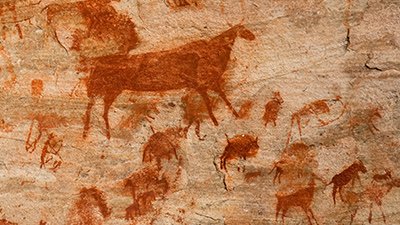
On the Skeleton's Orientation
In portraying cavemen as dimwits, popular stereotypes often show them as unkempt—and recklessly heterosexual—brutes: claiming brides by clubbing cavewomen over the head and dragging them away. But less frequently portrayed are “homosexual cavemen,” like the one supposedly unearthed in a Prague suburb.
News Source
- The Telegraph: “First Homosexual Caveman Found”
Archaeologists discovered the body, which is thought to be several thousand years old, in a position usually reserved for women. Specifically, the head was pointed eastward and surrounded by jugs, symbolism found only in the graves of females of the “Corded Ware” culture.
By contrast, men were buried with their heads pointing west, surrounded by weapons, hammers, knives, and even meals. (In addition to jugs, women of the period have been found buried with necklaces, jewelry, and a single pot.) That led archaeologist Katerina Semradova to conclude, “We believe this is one of the earliest cases of what could be described as a ‘transsexual’ or ‘third gender grave’ in the Czech Republic. . . . [We] believe the man was probably homosexual or transsexual.” (She noted that archaeologists have also found one case of a woman buried as a man.)
Team member Kamila Remisova Vesinova of the Czech Archaeological Society explained, “From history and ethnology, we know that people from this period took funeral rites very seriously so it is highly unlikely that this positioning was a mistake. Far more likely is that he was a man with a different sexual orientation, homosexual or transsexual.”
It is not hard to imagine other scenarios that might explain the feminine burial that do not require homosexuality.
Other archaeologists have criticized the team’s conclusions, however, on such grounds as whether transsexual implies homosexual and—in our opinion, more relevant—whether the scientists have done enough to show the skeleton was definitely a typical male’s (not transgender genetically or developmentally). And even if the skeleton was male, it is not hard to imagine other scenarios that might explain the feminine burial that do not require homosexuality, and it is not clear how the team inferred that none of these could be correct. (The same goes for the “woman” reportedly buried as a man.)
Of course, the Bible indicates that homosexual behavior was practiced in Abraham’s time (Genesis 19:4–5), so if it could somehow be confirmed that this was indeed a “homosexual caveman,” Bible believers would not be surprised. Nevertheless, we wonder whether such archaeological evidence of historical homosexuality, shaky as this finding may be, are tacitly intended to support the claim that homosexuality should be embraced—against the Bible’s clear teaching in such passages as 1 Corinthians 6:9, 1 Timothy 1:10, Jude 1:7, and others.
For More Information: Get Answers
Remember, if you see a news story that might merit some attention, let us know about it! (Note: if the story originates from the Associated Press, FOX News, MSNBC, the New York Times, or another major national media outlet, we will most likely have already heard about it.) And thanks to all of our readers who have submitted great news tips to us. If you didn’t catch all the latest News to Know, why not take a look to see what you’ve missed?
(Please note that links will take you directly to the source. Answers in Genesis is not responsible for content on the websites to which we refer. For more information, please see our Privacy Policy.)
Recommended Resources

Answers in Genesis is an apologetics ministry, dedicated to helping Christians defend their faith and proclaim the good news of Jesus Christ.
- Customer Service 800.778.3390
- © 2024 Answers in Genesis




